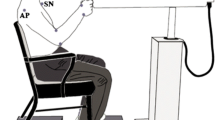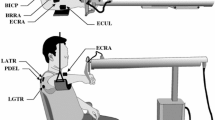Abstract
This study investigated the ability to use an internal model of the environmental dynamics when the dynamics were predictable but unstable. Subjects performed goal-directed movements using a robot manipulandum while counteracting a force field, which created instability by assisting the movement in proportion to hand velocity. Subjects’ performance was better on the last trial than on the first trial in the force field for all four movement directions tested: out, in, right and left. Subjects adapted to the force field primarily by increasing muscle co-contraction, compared to null field movements, during all phases of movement. This co-contraction generally declined for both the deceleration and stabilization phases during the course of the first 25 movements in each direction, but tended not to decrease significantly thereafter. Catch trials at the end of the learning period suggested that increased viscoelastic impedance due to muscle co-contraction was used to counteract the force field. Only in the case of outward movements were aftereffects observed that were consistent with formation of an accurate internal model of the force field dynamics. Stabilization of the hand for outward movements required less muscle co-contraction than for movements in other directions due to stability conferred by the geometry of the arm. The results suggest that the accuracy of an internal model depends critically on the stability of the coupled dynamics of the limb and the environment.










Similar content being viewed by others
References
Bhushan N, Shadmehr R (1999) Computational nature of human adaptive control during learning of reaching movements in force fields. Biol Cybern 81:39–60
Burdet E, Osu R, Franklin DW, Milner TE, Kawato M (2001) The central nervous system stabilizes unstable dynamics by learning optimal impedance. Nature 414:446–449
Conditt MA, Gandolfo F, Mussa-Ivaldi FA (1997) The motor system does not learn the dynamics of the arm by rote memorization of past experience. J Neurophysiol 78:554–560
Dolan JM, Friedman MB, Nagurka ML (1993) Dynamic and loaded impedance components in the maintenance of human arm posture. IEEE Trans Syst Man Cybern 23:698–709
Feldman AG (1980) Superposition of motor programs—II. Rapid forearm flexion in man. Neuroscience 5:91–95
Flanagan JR, Wing AM (1997) The role of internal models in motion planning and control: evidence from grip force adjustments during movements of hand-held loads. J Neurosci 17:1519–1528
Franklin DW, Milner TE (2003) Adaptive control of stiffness to stabilize hand position with large loads. Exp Brain Res 152:211–220
Franklin DW, Osu R, Burdet E, Kawato M, Milner TE (2003) Adaptation to stable and unstable dynamics achieved by combined impedance control and inverse dynamics model. J Neurophysiol (in press)
Gandolfo F, Mussa-Ivaldi FA, Bizzi E (1996) Motor learning by field approximation. Proc Natl Acad Sci 93:3843–3846
Goodbody SJ, Wolpert DM (1998) Temporal and amplitude generalization in motor learning. J Neurophysiol 79:1825–1838
Hinder MR, Milner TE (2003) The case for internal model versus equilibrium point control in human movement. J Physiol 549:953–963
Kawato M (1990) Feedback-error-learning neural network for supervised motor learning. In: Eckmiller R (ed) Advanced neural computers. North-Holland: Elsevier, Amsterdam, pp 365–372
Krakauer JW, Ghilardi MF, Ghez C (1999) Independent learning of internal models for kinematic and dynamic control of reaching. Nat Neurosci 2:1026–1031
Lackner JR, Dizio P (1994) Rapid adaptation to Coriolis force perturbations of arm trajectory. J Neurophysiol 72:299–313
Milner TE (2002a) Contribution of geometry and joint stiffness to mechanical stability of the human arm. Exp Brain Res143:515–519
Milner TE (2002b) Adaptation to destabilizing dynamics by means of muscle co-contraction. Exp Brain Res 143:406–416
Milner TE, Cloutier C (1993) Compensation for mechanically unstable loading in voluntary wrist movement. Exp Brain Res 94:522–532
Mussa Ivaldi FA, Hogan N, Bizzi E (1985) Neural, mechanical and geometric factors subserving arm posture in humans. J Neurosci 5:2732–2743
Rancourt D, Hogan N (2001) Stability in force-production tasks. J Mot Behav 33:193–204
Scheidt RA, Reinkensmeyer DJ, Conditt MA, Rymer WZ, Mussa-Ivaldi FA (2000) Persistence of motor adaptation during constrained, multi-joint, arm movements. J Neurophysiol 84:853–862
Singhose WE, Seering WP, Singer NC (1997) Time-optimal negative input shapers. J Dyn Sys Meas Control 119:198–205
Shadmehr R, Mussa-Ivaldi FA (1994) Adaptive representation of dynamics during learning of a motor task. J Neurosci 14:3208–3224
Takahashi CD, Scheidt RA, Reinkensmeyer DJ (2001) Impedance control and internal model formation when reaching in a randomly varying dynamical environment. J Neurophysiol 86:1047–1051
Thoroughman KA, Shadmehr R (1999) Electromyographic correlates of learning an internal model of reaching movements. J Neurosci 19:8573–8588
Tsuji T, Morasso PG, Goto K, Ito K (1995) Human hand impedance characteristics during maintained posture. Biol Cybern 72:475–485
Weiss PL, Hunter IW, Kearney RE (1988) Human ankle joint stiffness of the full range of activation levels. J Biomech 21:539–544
Acknowledgements
This work was conducted in the laboratory of Dr. Sandro Mussa-Ivaldi at the Rehabilitation Institute of Chicago. The work was supported by the Natural Sciences and Engineering Research Council of Canada and NINDS grant NS-35673.
Author information
Authors and Affiliations
Corresponding author
Rights and permissions
About this article
Cite this article
Milner, T.E. Accuracy of internal dynamics models in limb movements depends on stability. Exp Brain Res 159, 172–184 (2004). https://doi.org/10.1007/s00221-004-1944-8
Received:
Accepted:
Published:
Issue Date:
DOI: https://doi.org/10.1007/s00221-004-1944-8




